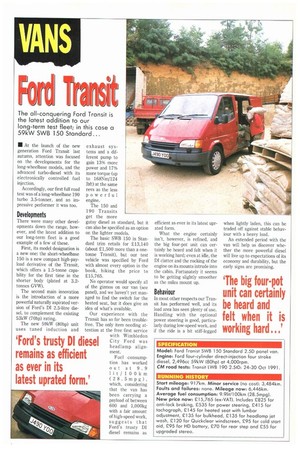VANS Ford itan
Page 43

If you've noticed an error in this article please click here to report it so we can fix it.
• At the launch of the new generation Ford Transit last autumn, attention was focused on the developments for the long-wheelbase models, and the advanced turbo-diesel with its electronically controlled fuel injection.
Accordingly, our first full road test was of a long-wheelbase 190 turbo 3.5-tonner, and an impressive performer it was too.
Developments
There were many other developments down the range, however, and the latest addition to our long-term fleet is a good example of a few of these.
First, its model designation is a new one: the short-wheelbase 150 is a new compact high-payload derivative of the Transit, which offers a 1.5-tonne capability for the first time in the shorter body (plated at 3.2tonnes GVW).
The second main innovation is the introduction of a more powerful naturally aspirated version of Ford's DI 2.5-litre diesel, to complement the existing 53kW (70hp) rating.
The new 59kW (80hp) unit uses tuned induction and exhaust systems and a different pump to gain 13% more power and 17% more torque (up to 168Nm/124 lbft) at the same revs as the less powerful engine.
The 150 and 190 Transits get the more gutsy diesel as standard, but it can also be specified as an option on the lighter models.
The basic SWB 150 in Standard trim retails for £13,140 (about £1,500 more than a onetonne Transit), but our test vehicle was specified by Ford with almost every option in the book, hiking the price to £15,765.
No operator would specify all of the gizmos on our van (see panel), and we haven't yet managed to find the switch for the heated seat, but it does give an idea of what's available.
Our experience with the Transit has so far been troublefree. The only item needing attention at the free first service with Wimbledon City Ford was headlamp alignment.
Fuel consumption has worked out at 9 . 9 lit/ 1 0 0 km ( 2 8 . 5 m p g ) , which, considering that the van has been carrying a payload of between 600 and 1,000kg with a fair amount of high-speed work, suggests that Ford's trusty D1 diesel remains as
efficient as ever in its latest uprated form.
What the engine certainly isn't, however, is refined, and the big four-pot unit can certainly be heard and felt when it is working hard; even at idle, the DI clatter and the rocking of the engine on its mounts intrude into the cabin. Fortunately it seems to be getting slightly smoother as the miles mount up.
Behaviour
In most other respects our Transit has performed well, and its load area has seen plenty of use. Handling with the optional power steering is good, particularly during low-speed work, and if the ride is a bit stiff-legged when lightly laden, this can be traded off against stable behaviour with a heavy load.
An extended period with the van will help us discover whether the more powerful diesel will live up to expectations of its economy and durability, but the early signs are promising.




















































































